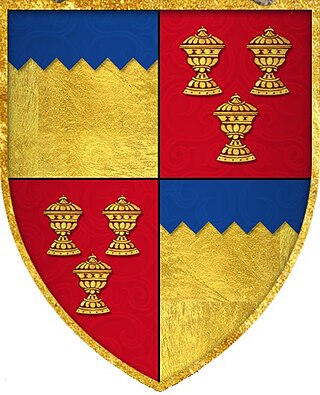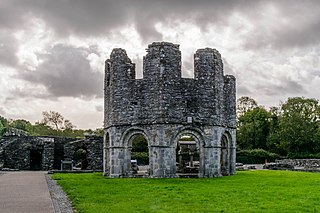
Lieutenant-General James FitzThomas Butler, 1st Duke of Ormond, KG, PC, was an Anglo-Irish statesman and soldier, known as Earl of Ormond from 1634 to 1642 and Marquess of Ormond from 1642 to 1661. Following the failure of the senior line of the Butler family, he was the second representative of the Kilcash branch to inherit the earldom.

Piers Butler, 8th Earl of Ormond, 1st Earl of Ossory also known as Red Piers, was from the Polestown branch of the Butler family of Ireland. In the succession crisis at the death of Thomas Butler, 7th Earl of Ormond he succeeded to the earldom as heir male, but lost the title in 1528 to Thomas Boleyn. He regained it after Boleyn's death in 1538.

The Dean of St Patrick's Cathedral is the senior cleric of the Protestant St Patrick's Cathedral, Dublin, elected by the chapter of the cathedral. The office was created in 1219 or 1220, by one of several charters granted to the cathedral by Archbishop Henry de Loundres between 1218 and 1220.
John Butler, Earl of Gowran (1643–1677) was an MP in the Irish Parliament 1661–1666 before being created Earl of Gowran in 1676. He married but died childless.

The Synod of Kells took place in 1152, under the presidency of Giovanni Cardinal Paparoni, and continued the process begun at the Synod of Ráth Breasail (1111) of reforming the Irish church. The sessions were divided between the abbeys of Kells and Mellifont, and in later times the synod has been called the Synod of Kells-Mellifont and the Synod of Mellifont-Kells.
The Archbishopric of Tuam existed from the mid twelfth century until 1839, with its seat at Tuam.
Edward King was a Church of Ireland Bishop of Elphin from 1611 to 1639.
Benjamin Parry was Church of Ireland Bishop of Ossory from 27 January 1678 until his death later the same year.
John Parry was Bishop of Ossory in the Church of Ireland from 1672 until his death.
Robert Fowler was an Anglo-Irish clergyman. He served as the Archbishop of Dublin in the Church of Ireland from 1779 until his death in 1801.
John de Burgh, or de Burgo, or Burke was an Irish Roman Catholic clergyman who served as Vicar Apostolic (1629–41) and Bishop of Clonfert (1642–47), and Archbishop of Tuam (1647–67).

Edward Parry was Church of Ireland Bishop of Killaloe, County Clare, Ireland from 28 March 1647 until his death 20 July 1650.
Malachy Ó Caollaidhe, also known as Malachy Queally, Malachias Quælly, O'Queely or O'Quechly was an Irish Roman Catholic Archbishop of Tuam. He was called by Irish writers Maelseachlainn Ua Cadhla, by John Colgan Queleus, and erroneously by Thomas Carte, O'Kelly.
Jemmett Browne was the Church of Ireland Bishop of Killaloe from 1743 to 1745, Bishop of Dromore for three months in the middle of 1745, Bishop of Cork and Ross from 1745 to 1772, Bishop of Elphin from 1772 to 1775, and finally Archbishop of Tuam from 1775 until his death in 1782.

Joseph Deane Bourke, 3rd Earl of Mayo was an Irish peer and cleric who held several high offices in the Church of Ireland including Bishop of Ferns and Leighlin (1772–82) and Archbishop of Tuam (1782–94).
The Dean of Killaloe is based at the Cathedral Church of St Flannan in Killaloe in the united diocese of Limerick, Killaloe and Ardfert within the Church of Ireland. The Dean of Killaloe is also Dean of St Brendans, Clonfert, Dean of Kilfenora, and both Dean and Provost of Kilmacduagh.
Edward Synge (1691–1762) was an Anglican bishop in the Church of Ireland who was the Bishop of Clonfert and Kilmacduagh (1730–1732), Bishop of Cloyne (1732–1734), Bishop of Ferns and Leighlin (1734–1740) and Bishop of Elphin (1740–1762).
Anthony Dopping was the Anglican Bishop of Meath, Ireland.

Sir Theophilus Jones, was an Irish soldier and government official of Welsh descent. One of five sons born to Lewis Jones, Bishop of Killaloe in the Church of Ireland, he formed part of a close-knit and powerful Protestant family.






